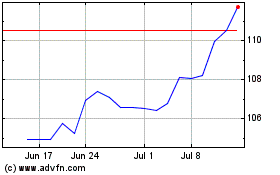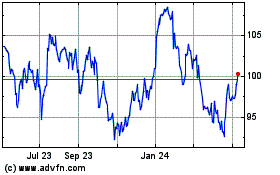By Denise Roland
This article is being republished as part of our daily
reproduction of WSJ.com articles that also appeared in the U.S.
print edition of The Wall Street Journal (November 20, 2018).
Novartis AG's recent acquisition streak is pivoting the company
toward new treatments that bear little resemblance to traditional
drugs.
The Swiss company has spent nearly $15 billion in the past year
to build its presence in cutting-edge areas of medical research,
including gene therapy, or treatments that introduce new DNA into
the body, and radiopharmaceuticals, which are drugs that carry
radioactive particles to tumors for close-range radiotherapy.
The deals build on Novartis's early move into a new form of
cancer therapy known as CAR-T, and underscore new Chief Executive
Vas Narasimhan's ambition to get ahead on innovative therapies that
he believes will drive significant future growth.
"We thought if we could gain a leadership position it'd be
harder for competition to take us on," Dr. Narasimhan, who led drug
development at Novartis before becoming CEO, said in an interview.
The 42-year-old Harvard-trained doctor said at a recent investor
event that he hopes such therapies will generate a fifth of
Novartis's revenue within five years. Currently, they are a tiny
fraction of its $49 billion in yearly sales.
The new treatments pose challenges. The jury is still out on how
gene therapies, which potentially offer one-time cures for
previously untreatable diseases, should be priced.
Radiopharmaceuticals are logistically challenging to deliver
because of the short half-life of the radioactive component.
Dr. Narasimhan acknowledged at the event that risks were higher
than with conventional drugs but added that "there's a risk in not
pushing into new technologies and new areas of science to find
breakthrough medicines."
In October last year, Novartis paid $3.9 billion for Advanced
Accelerator Applications, which makes a radiopharmaceutical for a
rare form of gut and pancreas cancer. Last month, it said it would
pay $2.1 billion for radiopharmaceutical specialist Endocyte Inc.,
which targets prostate cancer.
In April, it bought AveXis Inc., which is developing a gene
therapy aimed at a fatal infant muscle-wasting disease, for $8.7
billion. Novartis also struck a licensing deal in January giving it
the right to sell Spark Therapeutic Inc.'s gene therapy for a rare
eye disorder in Europe and other markets outside the U.S.
None of the new acquisitions are likely to generate a fast
return for Novartis. The therapy by Endocyte is still under
development. Meanwhile, the AveXis gene therapy is in the hands of
regulators, with a decision expected in the first half of next
year. AAA's radiopharmaceutical and Spark's gene therapy both
target rare conditions, with modest potential markets.
But they do position Novartis as a potential leader in these
areas: Today, just one gene therapy, Spark's Luxturna, and a
handful of radiopharmaceutical treatments, one of them Novartis's,
are available in the U.S.
Gene therapy is a fast-expanding area, with around 180 clinical
trials under way in the U.S. alone, according to Datamonitor
Healthcare. Novartis was the first to get U.S. approval for a
high-tech therapy known as CAR-T, where disease-fighting white
blood cells are removed from a patient, genetically modified to
enhance their cancer-fighting ability, and reinfused into the body.
Trials show its product, called Kymriah, improves survival rates
for certain forms of hard-to-treat blood cancer and typically only
needs to be given once.
"CAR-T made us start to think of things differently," said Liz
Barrett, head of Novartis Oncology. "Do you want to be in the world
of introducing incrementally better medicines" when "payers have a
much higher bar for what's reimbursed?"
Still, Novartis's experience with Kymriah underscores the
challenges associated with selling expensive medicines at a time
when drug pricing is attracting political scrutiny. Its price tag
of up to $475,000 per patient has attracted criticism from patient
groups. Novartis says its pricing is responsible, pointing to
independent studies that show Kymriah could command a price of
$600,000 to $750,000.
The high cost of Kymriah and the other currently available
CAR-T, Gilead Sciences Inc.'s Yescarta, is putting pressure on
hospitals, which in some cases lose money by offering the therapy,
says Joanna Hiatt Kim, vice president for payment policy at the
American Hospital Association. For now, many hospitals are
absorbing the cost because the number of patients is small, said
Ms. Kim. But as more such therapies become available, price is
likely to become a bigger sticking point.
"If you're losing $200,000 to $300,000 per case, there's simply
so many times you can do that," she said.
Novartis's move into gene therapy is likely to bring more
pricing controversy. The only gene therapy currently available in
the U.S. -- Spark's Luxturna -- costs $850,000 per patient, raising
questions about how health systems will be able to pay for such
treatments as they become more common.
"The economics of developing a drug are becoming much more
challenging," said Ed Schoonveld, pricing and market access expert
at health care consulting firm ZS Associates. Existing payment
models aren't set up to handle the high prices of the one-time
cures that gene therapies typically provide, he said.
Novartis says its leading gene therapy would be cost-effective
at $4 million a patient. While that would mean a high upfront cost,
the company says it would be in line with less expensive medicines
that need to be taken repeatedly. Novartis has yet to decide
pricing, and is conscious of potential push back.
"The media will put our one-day sticker price in the headline
without educating society that this is actually great value," Dr.
Narasimhan said. "We're giving a lifetime benefit."
To pre-empt pricing issues, Novartis is talking with some
insurers about different ways to pay, such as in installments or
depending on how well patients respond to therapy.
Still, such models also throw up problems. Novartis already
offers an outcome-based pricing option for Kymriah where it only
gets paid if patients are doing well 30 days after treatment. But
hospitals have questioned whether that time frame is appropriate
for assessing success, according to the AHA's Ms. Kim. The merit of
paying in installments is also challenged when a patient dies
before the treatment has been paid off.
Radiopharmaceuticals don't present the same pricing
difficulties. Lutathera, at $190,000 for a standard four-dose
course, is more in line with other new cancer drugs, according to
Novartis's Ms. Barrett.
But they are complex to produce. The radioactive component only
lasts about 72 hours, meaning they need to be made on demand and
sent quickly to the hospital that needs them.
Ms. Barrett said Lutathera's early commercial success -- it went
on sale in July -- was in part due to the company "working very
closely with institutions in making the logistics as easy as
possible."
While Novartis's strategy involves taking on some risk, its
first-mover role could play to its advantage, according to Dan
Mahony, a fund manager at Polar Capital LLC, which holds Novartis
stock. "That initial foray doesn't make them much money," he said,
"but it teaches them about how the market will work."
Write to Denise Roland at Denise.Roland@wsj.com
(END) Dow Jones Newswires
November 20, 2018 02:47 ET (07:47 GMT)
Copyright (c) 2018 Dow Jones & Company, Inc.
Novartis (NYSE:NVS)
Historical Stock Chart
From Mar 2024 to Apr 2024

Novartis (NYSE:NVS)
Historical Stock Chart
From Apr 2023 to Apr 2024
